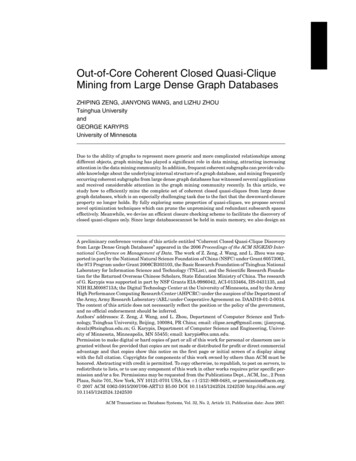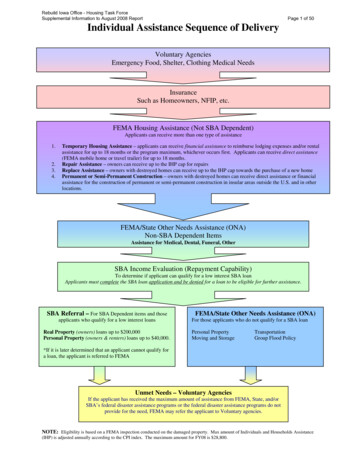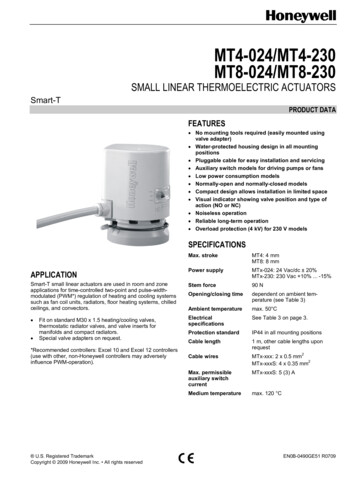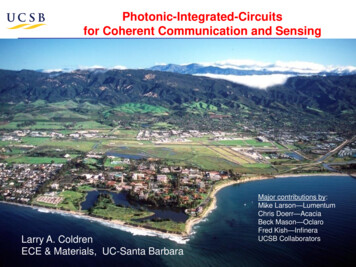
Transcription
Out-of-Core Coherent Closed Quasi-CliqueMining from Large Dense Graph DatabasesZHIPING ZENG, JIANYONG WANG, and LIZHU ZHOUTsinghua UniversityandGEORGE KARYPISUniversity of MinnesotaDue to the ability of graphs to represent more generic and more complicated relationships amongdifferent objects, graph mining has played a significant role in data mining, attracting increasingattention in the data mining community. In addition, frequent coherent subgraphs can provide valuable knowledge about the underlying internal structure of a graph database, and mining frequentlyoccurring coherent subgraphs from large dense graph databases has witnessed several applicationsand received considerable attention in the graph mining community recently. In this article, westudy how to efficiently mine the complete set of coherent closed quasi-cliques from large densegraph databases, which is an especially challenging task due to the fact that the downward-closureproperty no longer holds. By fully exploring some properties of quasi-cliques, we propose severalnovel optimization techniques which can prune the unpromising and redundant subsearch spaceseffectively. Meanwhile, we devise an efficient closure checking scheme to facilitate the discovery ofclosed quasi-cliques only. Since large databasescannot be held in main memory, we also design anA preliminary conference version of this article entitled “Coherent Closed Quasi-Clique Discoveryfrom Large Dense Graph Databases” appeared in the 2006 Proceedings of the ACM SIGKDD International Conference on Management of Data. The work of Z. Zeng, J. Wang, and L. Zhou was supported in part by the National Natural Science Foundation of China (NSFC) under Grant 60573061,the 973 Program under Grant 2006CB303103, the Basic Research Foundation of Tsinghua NationalLaboratory for Information Science and Technology (TNList), and the Scientific Research Foundation for the Returned Overseas Chinese Scholars, State Education Ministry of China. The researchof G. Karypis was supported in part by NSF Grants EIA-9986042, ACI-0133464, IIS-0431135, andNIH RLM008713A; the Digital Technology Center at the University of Minnesota, and by the ArmyHigh Performance Computing Research Center (AHPCRC) under the auspices of the Department ofthe Army, Army Research Laboratory (ARL) under Cooperative Agreement no. DAAD19-01-2-0014.The content of this article does not necessarily reflect the position or the policy of the government,and no official endorsement should be inferred.Authors’ addresses: Z. Zeng, J. Wang, and L. Zhou, Department of Computer Science and Technology, Tsinghua University, Beijing, 100084, PR China; email: clipse.zeng@gmail.com; {jianyong,dcszlz}@tsinghua.edu.cn; G. Karypis, Department of Computer Science and Engineering, University of Minnesota, Minneapolis, MN 55455; email: karypis@cs.umn.edu.Permission to make digital or hard copies of part or all of this work for personal or classroom use isgranted without fee provided that copies are not made or distributed for profit or direct commercialadvantage and that copies show this notice on the first page or initial screen of a display alongwith the full citation. Copyrights for components of this work owned by others than ACM must behonored. Abstracting with credit is permitted. To copy otherwise, to republish, to post on servers, toredistribute to lists, or to use any component of this work in other works requires prior specific permission and/or a fee. Permissions may be requested from the Publications Dept., ACM, Inc., 2 PennPlaza, Suite 701, New York, NY 10121-0701 USA, fax 1 (212) 869-0481, or permissions@acm.org. C 2007 ACM 0362-5915/2007/06-ART13 5.00 DOI 10.1145/1242524.1242530 http://doi.acm.org/10.1145/1242524.1242530ACM Transactions on Database Systems, Vol. 32, No. 2, Article 13, Publication date: June 2007.
2 Z. Zeng et al.out-of-core solution with efficient index structures for mining coherent closed quasi-cliques fromlarge dense graph databases. We call this Cocain*. Thorough performance study shows that Cocain*is very efficient and scalable for large dense graph databases.Categories and Subject Descriptors: H.2.8 [Database Management]: Database Applications—Data miningGeneral Terms: Algorithms, PerformanceAdditional Key Words and Phrases: Graph mining, quasi-clique, coherent subgraph, frequent closedsubgraph, out-of-core algorithmACM Reference Format:Zeng, Z., Wang, J., Zhou, L., and Karypis, G. 2007. Out-of-Core coherent closed quasi-clique miningfrom large dense graph databases. ACM Trans. Datab. Syst. 32, 2, Article 13 (June 2007), 40 pages.DOI 10.1145/1242524.1242530 http://doi.acm.org/10.1145/1242524.12425301. INTRODUCTIONData mining, whose goal is to discover implicit, previously unknown, and potentially useful information from massive data [Frawley et al. 1992], is expanding rapidly both in theory and in applications. A recent trend in data miningresearch is to consider more complex cases than those representable by singletable relational databases such as XML databases [Chen et al. 2003; Yang et al.2003], spatial databases [Zhang et al. 2005; Papadias et al. 2005], microarraydatabases [Hu et al. 2005], graph databases [Wang et al. 2006b; Horvath et al.2006], and so on. Both practical and theoretical problems should be solved forthe databases involving these complex data types due to the relationships between entities that are thereby introduced.As one of the central problems considered in the data mining community,the discovery of frequent patterns in a database, that is, patterns occuring inat least a certain specified number of elements of the database, has attractedmuch attention and made great progress in recent years. In addition to be interesting in their own right, frequent patterns can be used in mining associationrules [Agrawal and Srikant 1994; Klemettinen et al. 1994], correlations [Brinet al. 1997; Wang et al. 2006b], causality [Silverstein et al. 2000], sequence patterns [Agrawal and Srikant 1995; Zhang et al. 2005], episodes [Mannila et al.1997; Laxman and Unnikrishnan 2005] and emerging patterns [Dong and Li1999], and also can be used as building blocks or features for clustering [Huet al. 2002; Wang et al. 2002], classification [Matsuda et al. 1999; Hu et al. 2005;Yan et al. 2004], and predictive data mining tasks [Borgelt and Berthold 2002;Deshpande et al. 2005].Previous studies on frequent pattern discovery have concentrated on relatively simple notions of patterns and elements in the database, as they aretypically used for discovering association rules [Agrawal et al. 1993]. However, in a wide array of disciplines, data can be intuitively cast into graphpatterns [Chakrabarti and Faloutsos 2006]. Meanwhile, due to the significanceof application areas such as the analysis of chemical molecules [Borgelt andBerthold 2002] or graph structures in the World Wide Web [Broder et al. 2000],there has been increased interest in algorithms that can perform frequentACM Transactions on Database Systems, Vol. 32, No. 2, Article 13, Publication date: June 2007.
Out-of-Core Coherent Closed Quasi-Clique Mining from Large Dense Graph Databases pattern discovery in databases of structured objects, such as trees and arbitrary graphs.While the frequent connected subgraph mining problem for tree datasets canbe solved in incremental polynomial time (see Chi et al. [2005] for an overview offrequent subtree mining), it becomes intractable for arbitrary graph databases.However, one of the most general forms for modeling complex, structured datais that of the graph. Furthermore, graphs can naturally model increasinglygeneric and complicated relationships among different objects. Frequent subgraph mining has a wide range of applications, such as chemical compoundclassification [Dehaspe et al. 1998], functional annotation [Hu et al. 2005],and the discovery of activity-related groups of chemical compounds, contrastfragment structures, and functional modules among proteins. For all of thesereasons, the latter has become more and more significant, attracting muchattention in the data mining community. In past years, many frequent substructure mining algorithms have also been proposed, typical examples including AGM [Inokuchi et al. 2000], TreeMiner [Zaki 2002], FSG [Kuramochiand Karypis 2001], gSpan [Yan and Han 2002], PB [Vanetik et al. 2002],FFSM [Huan et al. 2003], CloseGraph [Yan and Han 2003], ADI-Mine [Wanget al. 2004], FPGrowth [Buehrer et al. 2006], EM [Hashimoto et al. 2006], Cocain [Zeng et al. 2006] and so on.However, graphs in general have undesirable theoretical properties with regard to algorithmic complexity. In terms of complexity theory, currently noefficient algorithms are known to determine if one graph is isomorphic to asubgraph of another. Furthermore, no efficient algorithm is known to performsystematic enumeration of the subgraphs of a given graph, a common facet ofdata mining algorithms. Although several algorithms for mining frequent connected subgraphs from datasets of arbitrary graphs have demonstrated theirperformance empirically, we note that this general problem cannot be solved inoutput polynomial time, unless P N P [Horvath et al. 2006].Meanwhile, several recent studies have shown that mining frequent coherentsubgraphs is especially useful [Hu et al. 2005; Pei et al. 2005; Yan et al. 2005;Wang et al. 2006b], where a coherent subgraph can be informally defined asa subgraph that satisfies a minimum cut bound (the formal definition can befound in Section 2.1), since the set of frequent coherent subgraphs mined froma graph database usually reflects the density distribution of the relationshipsamong objects in the database, and can provide valuable knowledge about theinternal structure of the graph database. Note that, in contrast to traditionalfrequent subgraph mining, in this new problem setting we do not require eachembedding of a given frequent coherent subgraph to have exactly the same edgetopology, but rather to have a sufficient number of embeddings in the graphdatabase, each having a highly connected set of vertices. Frequent coherentsubgraph mining has also experienced several applications [Hu et al. 2005;Wang et al. 2006b], and we will show two examples in the following.Example 1.1 (Highly Correlated Stock Discovery). A stock market datasetcorresponding to a certain period can be converted to a graph in the following way. A stock is represented by a vertex whose label is the stock name,ACM Transactions on Database Systems, Vol. 32, No. 2, Article 13, Publication date: June 2007.3
4 Z. Zeng et al.Fig. 1. The maximum closed clique in the stock market database with correlation coefficientthreshold 0.90 and minimum relative support threshold 100%.and an edge is used to connect two vertices if their correlation coefficient is nosmaller than a user-specified threshold. A coherent subgraph like a clique isvery meaningful from the application point of view, as it implies that the pricesof the stocks contained in a coherent subgraph usually evolve synchronouslyover time, and a change of one stock’s price can be used to predict a similarchange for the prices of all other stocks in the same subgraph [Boginski et al.2004; Wang et al. 2006b]. Figure 1 shows the maximum frequent closed cliquemined from 11 sets of US stock market data with correlation coefficient threshold 0.9 and minimum relative support threshold 100% (more details can befound in Wang et al. [2006b]).Example 1.2 (Functional Annotation). Similarly, a set of microarray datacan be converted to a graph in which each node represents a unique gene andan edge represents a strong similarity between the expression data of the twogenes corresponding to its two end-nodes. The similarity can also be measuredby a Pearson correlation coefficient. By mining coherent dense subgraphs froma massive microarray database, functional modules can be mined and usedto predict functions for uncharacterized genes. For example, Figure 2 showsa coherent subgraph discovered from the yeast microarray database by theCodense algorithm [Hu et al. 2005]. All five genes except ASC1 are known tobe involved in protein biosynthesis. ASC1 can therefore be predicted to havethe same function, as well.In addition, coherent subgraph mining has been shown useful in identifyingthe clusters of genes that are coexpressed, as well as their protein interacts [Peiet al. 2005], and in searching the maximal common structural features amongprotein molecular graphs [Kato and Takahashi 2001].During past years, several coherent subgraph discovery algorithms havebeen proposed [Hu et al. 2005; Pei et al. 2005; Yan et al. 2005; Wang et al.ACM Transactions on Database Systems, Vol. 32, No. 2, Article 13, Publication date: June 2007.
Out-of-Core Coherent Closed Quasi-Clique Mining from Large Dense Graph DatabasesRP S 24B RP S 26RP S 6BRP S 2AS C1P RL2BFig. 2. Coherent dense subgraph containing six genes mined from the yeast microarray databaseusing Codense.2006b]. However, each of the previously proposed algorithms has its own limitations. For example, the algorithm proposed in Pei et al. [2005] can onlymine quasi-cliques with exact 100% support threshold from a relational graphdatabase, where a relational graph is defined as a special type of graph structurewhose vertices are uniquely labeled [Yan et al. 2005]; similarly, the Clan algorithm [Wang et al. 2006b] can only mine fully connected frequent subgraphs(i.e., frequent cliques). In addition, all of the aforementioned algorithms arebased on the assumption that either the entire database or its majority can fitinto main memory. They cannot adapt to large dense databases. In this article,we study a more general problem formulation: mining frequent quasi-cliquesfrom large dense graph databases, that is, we neither limit the minimum support to 100% nor require the input graphs to be relational. While the problembecomes more general, it gets more difficult. As we will see later, the downwardclosure property [Agrawal and Srikant 1994] no longer holds (the same problemis faced by Pei et al. [2005] and Zhang et al. [2005]), thus devising some effectivesearch-space pruning techniques is especially challenging. By fully exploringsome properties of quasi-cliques, we propose several novel optimization techniques, and also an efficient closure checking scheme in order to facilitate thediscovery of closed quasi-cliques only. Meanwhile, we develop an efficient coherent closed quasi-clique mining algorithm, Cocain*, and some efficient indexstructures for mining out-of-core structures.2. PROBLEM FORMULATIONIn this section, we introduce some preliminary concepts, notation, and terms inorder to simplify our following discussion. We also formulate the problem of mining frequent closed coherent quasi-cliques from graph transaction databases.Table I summarizes some common notations used in graph theory and theirmeanings.2.1 PreliminariesIn this article, we consider a simple graph only, which does not contain selfloops, multiedges, or edge labels. An undirected vertex-labeled graph transaction G can be represented by a 4-tuple G (V , E, L, F ). If G k, G is calledACM Transactions on Database Systems, Vol. 32, No. 2, Article 13, Publication date: June 2007.5
6Z. Zeng et al.Table I. Notations Used in This ArticleNotationsVELFG G L(v)G(S)N G (v)degG (v)d isG (u, v)GVcad(g)GVvad(g)DescriptionV {v1 , v2 , ., vk }, the set of verticesE V V , the set of edgesthe set of vertex labelsF : V L, the mapping function from labels to verticesG (V , E, L, F ), an undirected vertex-labeled graph transaction G V , the cardinality of Gthe label of vertex vthe induced subgraph on S from G, where S V (G)N G (v) {u (v, u) E(G)}degG (v) N G (v) the number of edges in the shortest path between u and v in Gthe set of extensible candidate vertices with respect to g in Gthe set of valid extensible candidate vertices with respect to g in Gv1u1aav4v2cbv5dbGraph g 1v3e3u3acbe1u2bu5bdcbu4Graph g 2e2e4Graph g 3Fig. 3. Examples of a 0.5-quasi-clique.a k-graph. A graph G is said to be connected if u, v V (G), d isG (u, v) (i.e., there is a path from any vertex to any other vertex in the graph G). A graphthat is not connected is said to be disconnected. Moreover, an induced subgraphof a graph G is a subset of the vertices of V (G), together with any edges whoseendpoints are all in this subset. In the following discussions, the term “graph”means the undirected vertex-labeled graph, unless otherwise stated. Next wewill introduce the formal definition of quasi-cliques.Definition 2.1 (γ -Quasi-clique). A k-graph(k 1) G is a γ -quasiclique (0 γ 1) if v V (G), degG (v) γ · (k 1) .From the preceding definition we can see that quasi-cliques are subgraphsthat satisfy a user-specified minimum vertex degree bound γ · (k 1) . Apparently, a γ -quasi-clique must be a fully connected graph when γ 1. This definition also means that singleton graphs are considered as γ -quasi-cliques. Givena k-graph G, if v V (G) such that degG (v) γ ·(k 1) and γ ·(k 1) γ ·k ,v is called a critical vertex of G with respect to γ .As shown in Figure 3, v V ( g 1 ), deg g 1 (v) 2 0.5 (5 1) ,so g 1 is a 0.5-quasi-clique. Since deg g 1 (v3 ) 0.5 4 and 0.5 4 ACM Transactions on Database Systems, Vol. 32, No. 2, Article 13, Publication date: June 2007.
Out-of-Core Coherent Closed Quasi-Clique Mining from Large Dense Graph Databases Minimum Degree 2, Minimum Edge Cut 1Fig. 4. A sample graph whose edge connectivity is smaller than minimum vertex degree.0.5 5 , v3 is a critical vertex of g 1 with respect to 0.5. However, g 1 is not a0.6-quasi-clique, as there exists a vertex v (e.g., v2 and v3 ) such that deg g 1 (v) 0.6 (5 1) .Most existing frequent subgraph mining algorithms are based on thedownward-closure property [Agrawal and Srikant 1994]. Unfortunately, thisnice property does not hold for quasi-clique patterns. An induced subgraphof a γ -quasi-clique may not be a γ -quasi-clique. For instance, in Figure 3,g 2 is a 0.5-quasi-clique, but one of its induced subgraphs, g 2 ({u3 , u4 , u5 }),is not.Definition 2.2 (Edge Cut and Edge Connectivity). Given a connected graphG (V , E), an edge cut is a set of edges Ec such that G (V , E Ec ) isdisconnected. A minimum cut is the smallest set among all edge cuts. The edgeconnectivity of G, denoted by κ(G), is the size of the minimum cut.As shown in Yan et al. [2005], although the minimum vertex degree can reflect the level of connectivity of a graph to some extent, it cannot guaranteethat the graph is connected in a balanced way, as the edge connectivity mightbe much smaller than the minimum vertex degree. Figure 4 shows such anexample. However, the following lemma gives a lower bound on the edge connectivity of a γ -quasi-clique with γ 0.5, which guarantees the coherency ofthe γ -quasi-clique when γ 0.5 holds.LEMMA 2.1 (MINIMUM EDGE CONNECTIVITY). Let n-graph Q (V , E) be a γ quasi-clique (0.5 γ 1, n 2). The edge connectivity of Q cannot be smallerthan n2 , namely, κ(Q) n2 .PROOF. Let us divide V into two nonempty sets V1 and V2 , and suppose V1 V2 and V1 k, then 1 k n2 must hold.Since Q is a γ -quasi-clique, v V1 , deg Q (v) γ · (n 1) . However, v is atmost adjacent to other k 1 vertices in V1 , and k 1 n2 1 γ (n 1). Therefore,v must be adjacent to vertices belonging to V2 , and the number of edges whichconnect v and vertices in V2 must be no smaller than γ · (n 1) (k 1).There are k vertices in V1 , so there exist at least k · ( γ · (n 1) (k 1)) edgesACM Transactions on Database Systems, Vol. 32, No. 2, Article 13, Publication date: June 2007.7
8 Z. Zeng et al.connecting V1 and V2 . Let f (k) k · ( γ · (n 1) (k 1)), thenf (k) k 2 k · ( γ · (n 1) 1).(1)d 2 f (k)d k2The second-order derivative of f (k) (i.e., 2) is negative, and f (k) 1achieves the maximum at its sole stationary point k γ ·(n 1). As there2exists only one stationary point for quadratic polynomial function f (k) and1 k n2 , f (k) must get its minimum either at k 1 or at k n2 . Whenk 1, f (1) γ · (n 1) n 1 n2 , while when k n2 , each vertex in V12must be adjacent to at least one vertex in V2 , thus f ( n2 ) V2 n2 . Fromthe previous result, we can get that k [1, n2 ], f (k) n2 . According to thedefinition of edge connectivity, κ(Q) n2 .Because we are more interested in mining tightly connected subgraphs,we do not expect that the edge connectivity of a subgraph pattern is toosmall in comparison with the minimum vertex degree. From Lemma 2.1 weknow that if γ 0.5, the minimum cut of a γ -quasi-clique is no smallerthan half the size of the corresponding quasi-clique, which assures that thevertices in the γ -quasi-clique are connected tightly and relatively evenly.In this article, a γ -quasi-clique is said to be coherent if γ 0.5, and ifnot explicitly stated, the parameter γ by default has a value no smallerthan 0.5.Definition 2.3 (γ -Isomorphism). A graph G 1 {V1 , E1 , L1 , F1 } is γ isomorphic to another graph G 2 {V2 , E2 , L2 , F2 } iff both are γ -quasi-cliques, G 1 G 2 , and there exists a bijection f : V1 V2 such that v V1 , F1 (v) F2 ( f (v)).According to the definition of γ -isomorphism, we know that γ -isomorphismis quite different from the graph isomorphism in graph theory, which is definedas a bijection f : V (G 1 ) V (G 2 ) from a graph G 1 to another graph G 2 suchthat (u, v) E(G 1 ) iff ( f (u), f (v)) E(G 2 ). The γ -isomorphism between twoγ -quasi-cliques does not imply an exact bijective edge mapping. For example,in Figure 3, g 1 and g 2 are 0.5-isomorphic to each other, although they are notgraph-isomorphic to each other.A multiset is defined as a bag of vertex labels in which the order is ignored,but multiplicity is explicitly significant, for example, multisets {1, 2, 3} and{3, 1, 2} are equivalent, but {1, 2, 3} and {3, 1, 1, 2} differ. Let M (G) indicatethe multiset of labels of a graph G. Hence, in Figure 3, M ( g 1 ) {a, b, b, c, d }and M ( g 3 ) {a, b, b, c}. From the γ -isomorphism definition, we can derive thefollowing lemma.LEMMA 2.2. Two γ -quasi-cliques Q 1 and Q 2 are γ -isomorphic to each otheriff M (Q 1 ) M (Q 2 ).Lemma 2.2 can be used to detect the existence of γ -isomorphism betweentwo graphs, that is, we just need to check if they are both γ -quasi-cliques andtheir multisets are equivalent.For two γ -quasi-cliques Q and Q , if M (Q) M (Q ), Q is called a subquasiclique of Q , while Q is called a superquasi-clique of Q. We use Q Q orACM Transactions on Database Systems, Vol. 32, No. 2, Article 13, Publication date: June 2007.
Out-of-Core Coherent Closed Quasi-Clique Mining from Large Dense Graph Databasesu1u4v4v2abcbu3u5du2bceGraph G 1u6 v3dcv1abv5v6Graph G 2Fig. 5. An example of a graph transaction database D.Q Q (i.e., Q Q but Q Q ), respectively, to denote the subquasi-cliqueor proper subquasi-clique relationship.2.2 Problem DefinitionA graph transaction database D consists of a set of input graphs, and the cardinality of D is denoted by D . Figure 5 shows an example of a graph transactiondatabase D which consists of two input graphs G 1 and G 2 , and D 2. Forsimplicity, in the rest of this article we sometimes omit the notation of databaseD when the context is clear.For two graphs G and G , let g be an induced subgraph of G, if M ( g ) M (G ),then we call g an instance of G in G. If there exists at least one instance ofG in G, we say that graph G roughly supports G , while graph G is roughlysupported by G. Meanwhile, if g is γ -isomorphic to another γ -quasi-clique Q,we call g an embedding of Q in G. If there exists at least one embedding of Q inG, then G is said to strictly support Q, while Q is said to be strictly supportedby G.The number of input graphs in graph database D that strictly (or roughly)support a γ -quasi-clique Q (or a graph G) is called the absolute strict-support(or absolute rough-support) of Q (or G) in D, denoted by supsD (Q) (or suprD (G)),while the relative strict-support (or relative rough-support) is the percentageof input graphs which strictly (or roughly) support Q (or G), denoted byrsupsD (Q) (or rsuprD (G)). Obviously, rsupsD (Q) supsD (Q)/ D , and rsuprD (G) suprD (G)/ D .For an absolute support threshold min sup and graph transaction databaseD, a quasi-clique Q (or a subgraph g ) is called a frequent quasi-clique (or a vicefrequent graph) if supsD (Q) min sup (or suprD ( g ) min sup). If there doesnot exist any other quasi-clique Q such that Q Q and supsD (Q) supsD (Q ),then Q is called a closed quasi-clique in D.1Problem Definition. Given a graph transaction database D and a minimumstrict-support threshold min sup, we study the problem of mining the completeset of γ -quasi-cliques in D that are frequent, closed, and coherent (i.e., γ 0.5).1 Herethe definition of a “closed” pattern is a little different from the traditional because thedownward-closure property does not hold for frequent quasi-clique mining, and it is possible thata quasi-clique’s strict-support is greater than that of its subquasi-cliques. Also, in the case whereQ Q and supsD (Q) supsD (Q ), we say Q can subsume Q.ACM Transactions on Database Systems, Vol. 32, No. 2, Article 13, Publication date: June 2007.9
10 Z. Zeng et al.3. RELATED WORKComputing clique or quasi-clique structures from a single graph has long beenstudied [Karp 1972; Bron and Kerbosch 1973; Feige et al. 1991; Hastad 1996;Abello et al. 2002; Ostergard 2002] and identifying the size of the largest cliquein a graph was one of the first problems shown NP-hard [Karp 1972]. However,these previous works did not study the problem of mining quasi-cliques thatfrequently occur across a set of input graphs. Recently, several algorithms wereproposed to mine frequent dense subgraphs from large graph databases, suchas Codense [Hu et al. 2005], Crochet [Pei et al. 2005], CloseCut and SPLAT [Yanet al. 2005], Clan [Wang et al. 2006b], and so on. In addition, according to ourdefinition of a quasi-clique, we do not require that there exists an edge for eachpair of vertices in a quasi-clique, thus mining closed quasi-cliques is similarto some extent to some variations of formal concept analysis, such as δ-freesets [Selmaoui et al. 2006] and biclustering of categorical data [Pensa et al.2005], which also allow for a certain number of zeros in a rectangle of ones.In Hu et al. [2005], the Codense algorithm was devised to mine frequentcoherent dense subgraphs across massive biological networks and to discoverfunctionally homogenous clusters. The problem formulation in Hu et al. [2005]is quite different from ours, and a frequent coherent dense subgraph mined byCodense might not necessarily be a frequent quasi-clique. In Yan et al. [2005],two approaches, CloseCut and Splat, were proposed to mine frequent closedsubgraphs with connectivity constraints. They can only be applied to relationalgraph databases. The problem studied in Yan et al. [2005] also differs from ours.Probably the most related research is that in Pei et al. [2005] and [Wang et al.2006b], which have their own limitations compared with this work. The Crochetalgorithm proposed in Pei et al. [2005] can mine quasi-cliques, but requires eachmined quasi-clique to have a perfect 100% support threshold, and also onlyworks for relational graph databases. Meanwhile, the Clan algorithm proposedin Wang et al. [2006b] neither requires the input graphs to be relational norlimits the support threshold to be exactly 100%, but can only mine frequentclosed cliques, that is, fully connected subgraphs.In a preliminary version of this work [Zeng et al. 2006], we studied a moregeneral problem formulation, that is, mining frequent closed quasi-cliques fromlarge dense graph databases, and designed an efficient closed coherent quasiclique discovery algorithm, Cocain. In Cocain, we neither limit the minimumsupport to be 100% nor require input graphs to be relational. Moreover, thedownward-closure property holds for clique patterns, thus designing some pruning techniques for frequent clique mining is much easier compared with quasiclique mining. However, by fully exploring some nice properties of quasi-cliquepatterns, we proposed several novel apriori-like pruning techniques which canbe pushed deeply into the mining process. Furthermore, we also devised anefficient closure checking scheme in order to facilitate the discovery of closedquasi-cliques only.As a major value-added version of our preliminary work [Zeng et al. 2006],we here summarize the major extensions as follows. First, Cocain and all theaforementioned algorithms are in-memory solutions which are based on theACM Transactions on Database Systems, Vol. 32, No. 2, Article 13, Publication date: June 2007.
Out-of-Core Coherent Closed Quasi-Clique Mining from Large Dense Graph Databases assumption that the entire graph database or at least its majority can fit intothe main memory. However, in most real applications, the graph databases areusually too large to be held in memory. In order to adapt to the huge graphdatabase setting, we devise an effective out-of-core solution based on severalnewly proposed efficient index structures. Our scalability study shows thatthe extended algorithm, Cocain*, can scale to very large databases. Second,some of the basic operations for calculating valid extensible vertex candidatesin the algorithm are very time consuming, thus, we propose some new optimization techniques and devise a new subalgorithm, Valid . Our performancestudy shows that these optimization techniques are very effective in improvingthe algorithm performance. Finally, we have conducted extensive
by a Pearson correlation coefficient. By mining coherent dense subgraphs from a massive microarray database, functional modules can be mined and used to predict functions for uncharacterized genes. For example, Figure 2 shows a coherent subgraph discovered from the yeast microarray database by the Codense algorithm [Hu et al. 2005].










